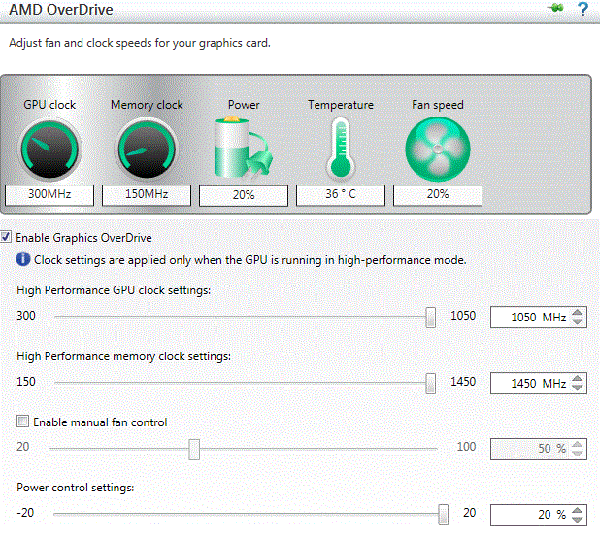XFX has launched a special graphics card for the budget conscious gamers and it’s called XFX Black DD Radeon 7850 975M. XFX’s Black Edition cards traditionally pack only the best GPUs and this time around it comes overclocked from reference 860MHz to 975MHz. The memory got a slightly lower overclock from 1200MHz (4800MHz GDDR5) to 1250MHz (5000MHz GDDR5 effectively). All in all, this seems like a decent overclock that should turn into gaming performance. Another good thing about HD 7850 as well as HD 7870 cards is that AMD strapped the cards with 2GB of memory on 256-bit memory interface, which will be of much use to gamers running 1920x1080.
In order to compensate for higher temperatures, the card comes with powerful Double Dissipation cooler – a cooler with a special heatsink and two fans. Interestingly enough, this cooler was made for much faster HD 7870, meaning that its capabilities will far exceed the demands of Pitcairn Pro GPUs. In turn, XFX could slow down the fans and make the card almost inaudible, even when under full load.
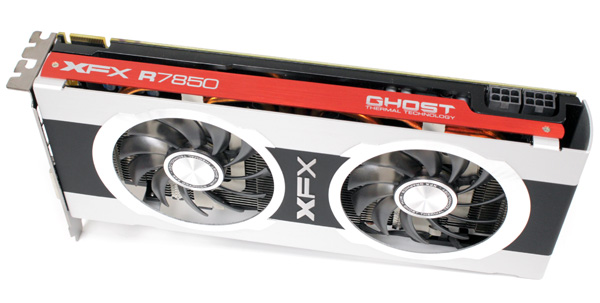
You’ll notice that XFX’s R7850 Black Edition is powered via two power connectors, a result of using the PCB made for HD 7870 cards. As far as consumption goes, XFX shouldn’t draw more than any other overclocked HD 7850, which usually comes with a single power connector.
Compared to Pitcairn XT, Pitcairn Pro comes with less shaders (1024 compared to XT’s 1280), and less texture units (64 compared to XT’s 80). Both GPUs come with 256-bit memory interface and 30 ROPs each. HD 7850 launched priced at $249, while HD 7870 cost $349. In order to justify the higher price for HD 7870 cards, AMD set the reference clocks for Pitcairn XT at 1000MHz and Pitcairn Pro to 860MHz.
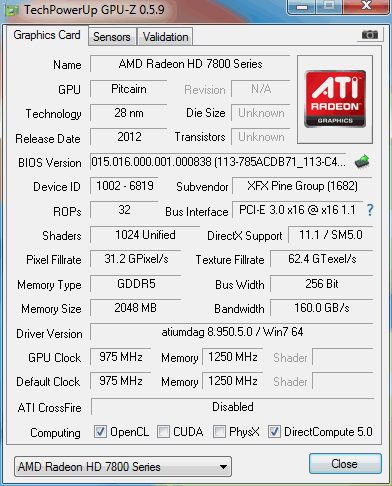
XFX’s standard packaging for the HD 7000 series is almost identical to that for the HD 5000/6000 series. The cardboard is tough and will shield the card from the usual abuse in transport. We really like the design of the box as well – not many packages are this compact, yet tough enough to keep the card safe.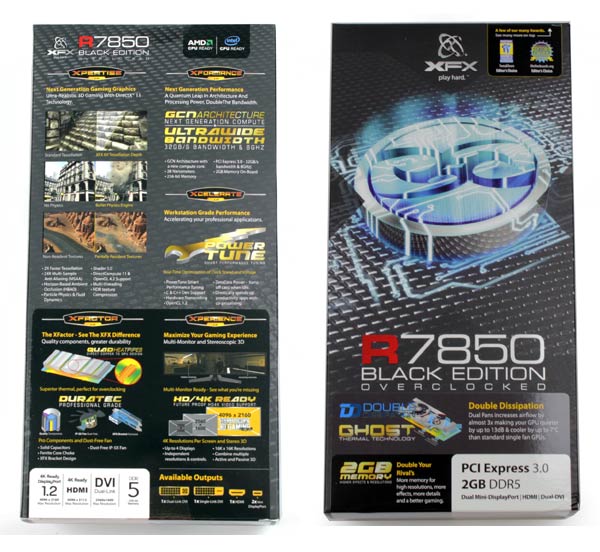
In the box we found a CrossFire conector, Black Edition badge, driver CD, short user manual and a few ads. XFX opted on standard sized connectors, so there are no additional converters in the box.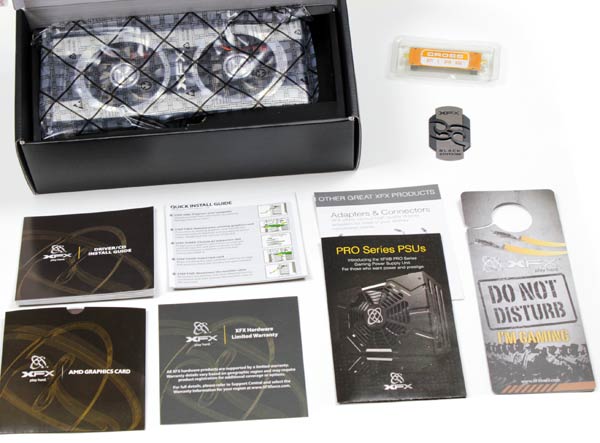
XFX’s R7850 Black Edition’s full name is Black DD Radeon 7850 975M 2GB D5 2Xm DP HDMI 2XDVI (Part No.: FX-785a-CDBC). Hand in hand with its launch of AMD 7000 series of graphics cards, XFX introduced the Ghost cooler. It comes in two flavors – single and double fan versions. The latter is called Double Dissipation (DD) and is the one used by our test card. The version with two fans is quieter and offers better overclocking potential. All the coolers used by XFX on HD 7900/7800/7700 series were two slots wide, regardless of whether they had a single or two fans.
Ghost cooler has no plastic parts – it’s all metal, aluminum and copper. The weight and quality are felt from the moment you grab the card and we must admit the DD cooler is quite a looker. The card’s name is written on a large aluminum strip on top of the cooler and it will most certainly look at home in any case with a side panel window. 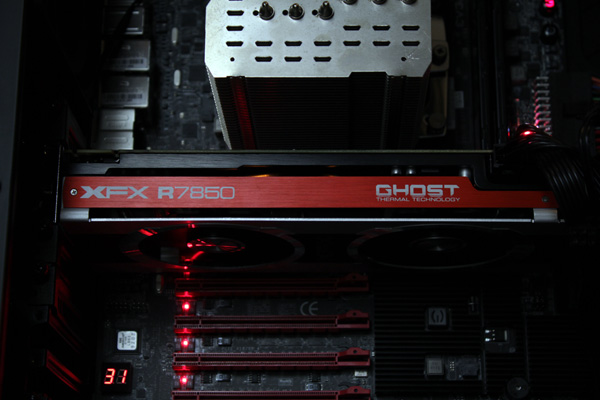
A wide black strip stretches across the cooler but it’s there purely for aesthetic reasons. We were quite impressed to see XFX use the soft-touch coating that we haven’t seen much after Nvidia’s GTX 290.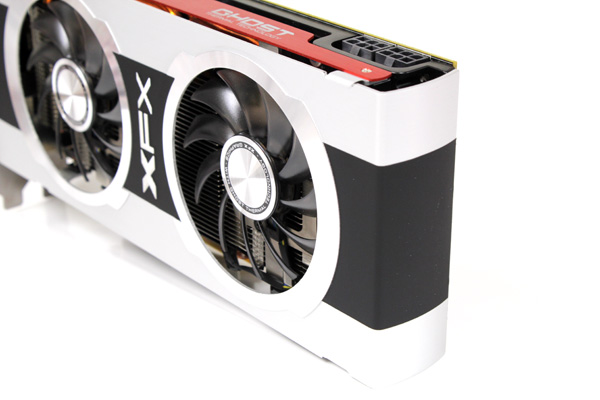
Although they may seem identical at a glance, Double Dissipation coolers on HD 7900/7800/7700 series are quite different. Namely, the HD 7900 series cooler uses vapor chamber technology; HD 7800 uses heatpipes while HD 7700 series relies on copper blocks combined with aluminum heatsinks. The difference in build quality is understandable seeing as how the cards are in different price ranges and don’t really have identical thermal properties.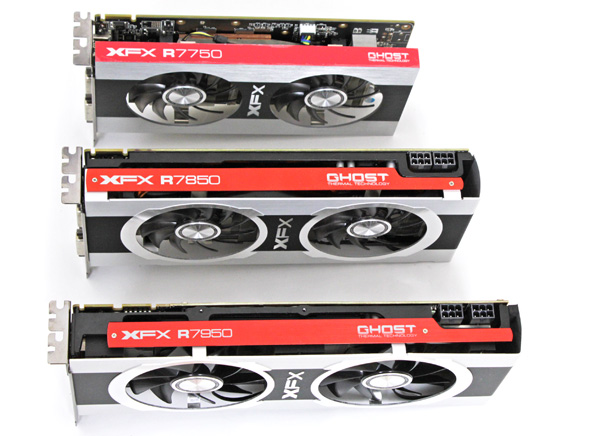
The R7700’s DD cooler is 21.3cm long and visibly cheaper – it has no soft-touch coating, no chromed outlet rings, no stylish aluminum bar on top of the cooler nor does the cooler close the end of the card, which is the case with faster models. Still, there’s no cheap plastic inside and this DD cooler’s performance is one of the best and quietest we’ve had so far.
As far as performance goes, DD coolers are tailored to the cards’ specific needs and really do excel in what they’re made to do.
The R7900 series’ DD cooler is about 27cm long, while the R7800’s is about 25cm. The aluminum shroud on both coolers seems identical as both feature soft-touch coating and chromed outlet rings. IP5X Dust Free fans prevent dust from penetrating the fans, prolonging their life while ensuring optimum performance levels.
The Black Edition R7850’s cooler uses four heatpipes in charge of heat transfer.
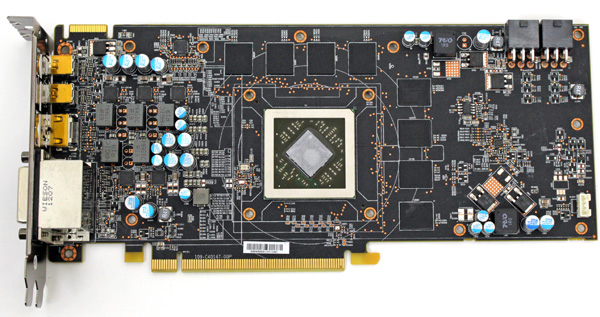
It’s interesting to see that XFX opted on using the HD 7870’s PCB. This is why the DD cooler can be used on both cards. Truth be told, AMD used identical PCBs for 7870 and 7850 cards upon launch but almost all partners chose the shorter PCB, which uses a single 6-pin power connector.
The Black DD R7850 975M card draws power via two 6-pin power connectors. Specs list a TDP of 130W for HD 7850 cards, but XFX wanted to make sure that the overclocked Pitcairn Pro chip has some headroom. The second power connector will come in very handy for further overclocking, especially since the original 130W TDP design is pretty close to the 150W limit on 6-pin power connectors.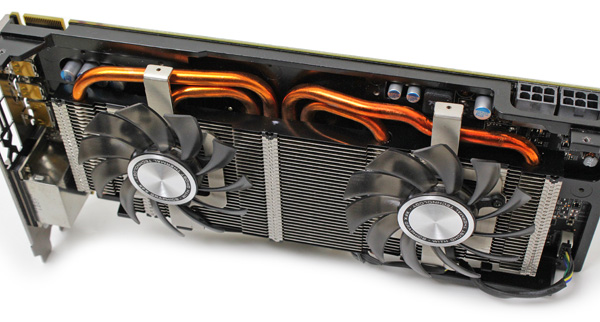

XFX DD Radeon 7850 975M card is equipped with 2048MB GDDR5 memory. The GDDR5 memory chips are made by Hynix (model number H5GQ2H24MFR-T2C). They are specified to run at 1250MHz (effective 5000MHz).

The holes in the bracket are important with closed, tunnel designs where the fan is at the end of the cooler. The XFX logo leaves more room for air exiting but it won't matter much with XFX's DD Radeon 7850 card. Namely, the cooler is open design so air exits all around the card and not only through the holes in the bracket. XFX's Bracket Design is definitely among the details that will make XFX's cards instantly recognizable.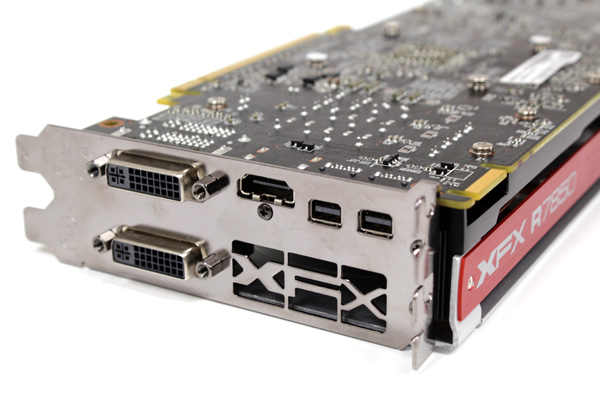
Knowing that the cooler can handle the factory overclocked Pitcairn Pro chip, XFX could use a part of the bracket for the second dual-link DVI out. AMD’s reference design uses the closed, tunnel type cooler with a fan at the end of the card. The reference design uses two mini DisplayPort 1.2 connectors and a single dual-link DVI out, but XFX though it was better to include a standard DisplayPort 1.2 and two dual-link DVIs. Both designs provide users with standard HDMI 1.4a connectors. HDMI 1.4a provides HD audio and support for Blu-ray 3D movies.
XFX's DD Radeon 7850 will simultaneously support three displays, although the third display will have to be via DisplayPort.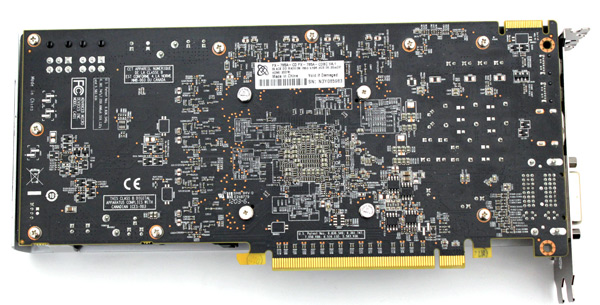
You may combine the XFX's Black DD Radeon 7850 card with another HD 7850 card from any vendor in CrossFire.
Motherboard: EVGA X79 FTW
CPU: Sandy Bridge-E Core i7 3820 (3.6GHz)
CPU Cooler: Thermalright HR-02 (Thermalright-Europa Distri www.PC-Cooling.de).
Memory: 8GB ADATA DDR3 1600 XPG Gaming series
Harddisk: OCZ Vertex 2 100 GB
Power Supply: CoolerMaster Silent Pro 1000W
Case: CoolerMaster Cosmos II Ultra Tower
Operating System: Win7 64-bit
Nvidia 301.10-desktop-win7-winvista-64bit-english-whql
amd_radeon_hd_7800_8.95.5_win7-64
12-3_vista_win7_64_dd_ccc.exe
3Dmark 2011
Crysis 2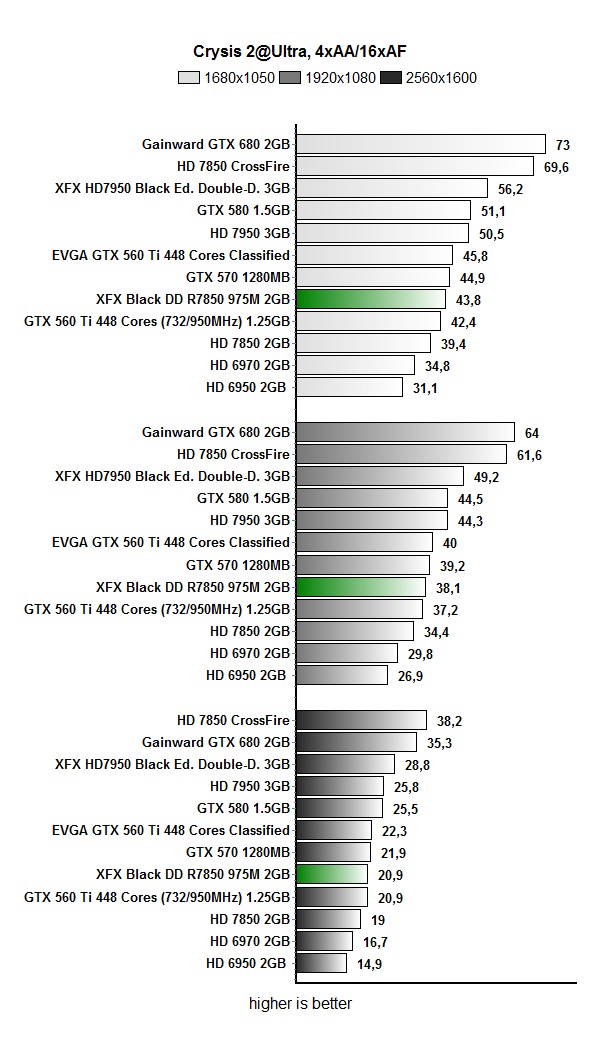
Aliens vs Predator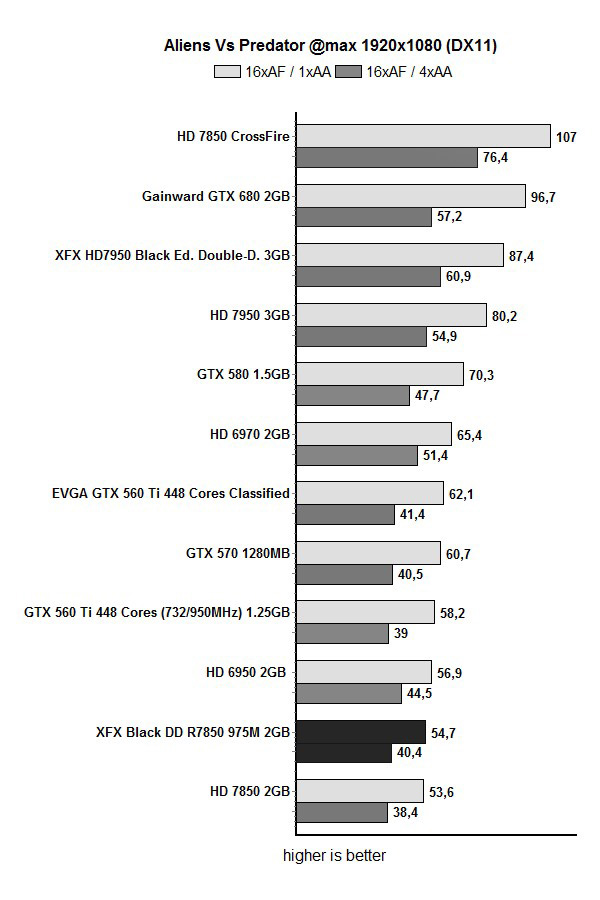
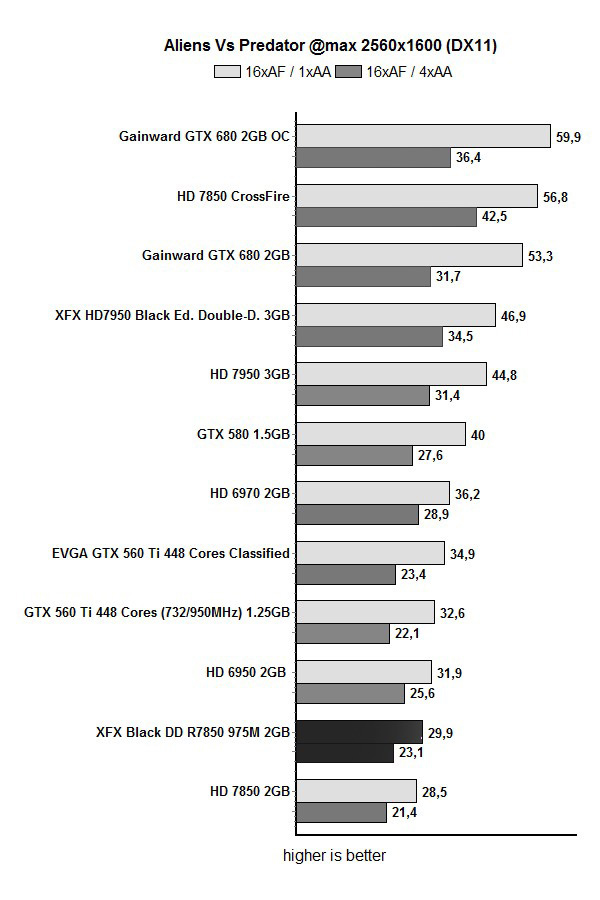
Metro 2033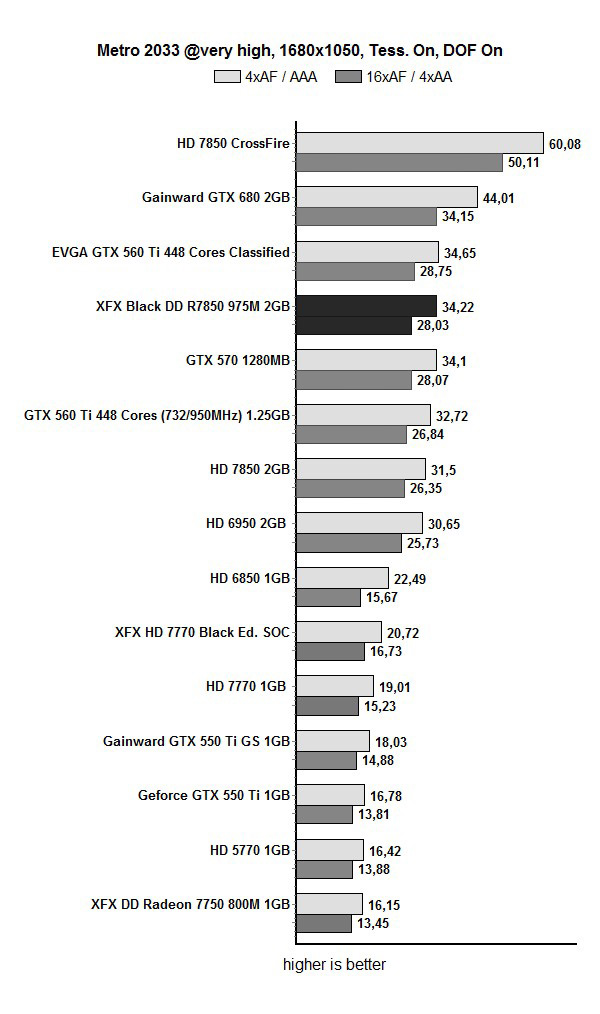

Unigine Heaven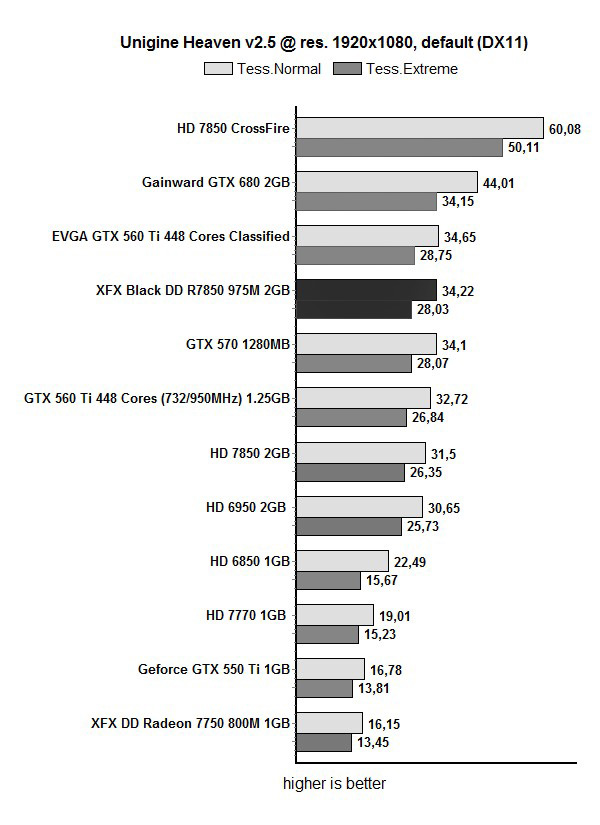
XFX Black DD Radeon 7850 975M is one of the quietest cards we’ve had in our lab - thermals are good and the card is almost inaudible all the time. Note that the card is inaudible when idle. DD cooler's superiority in cooling Black R7850 graphics card was expected since the cooler was designed to cool overclocked R7870 cards. In fact, not even further overclocking of the GPU (from 975MHz to 1050MHz) managed to change that. The highest temperature we measured after a long session of playing Crysis 2 was 73°C.
XFX fans are designed to use linear fan speed ramping controls so that fan speeds and temperatures are optimized to reduce excess noise. This helps by preventing sudden fan speed changes that tend to get loud. 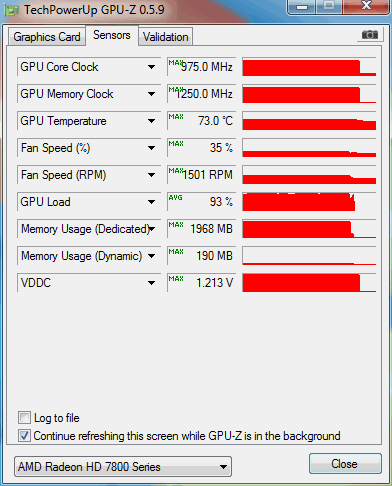
XFX factory overclocked the top Pitcairn Pro graphics chips and used them for its Black Edition branded Radeon 7850 cards. The 7850 reference clocks are 860MHz for GPU and 1200MHz for memory, but XFX overclocked the GPU by 115MHz and the memory by 50MHz (to 975MHz and 1250MHz respectively).
AMD Overdrive supports overclocking but AMD limited it to 1050MHz. XFX Black R7850 ran happily at this clock. The same happened with our memory overclock attempt, as AMD Overdrive had its own slider limits.
GPU temperature was great even after the overclock, only a degree or two higher than normal.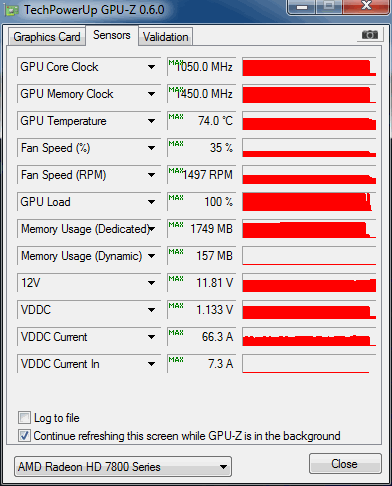
AMD power regulator does dynamic monitoring of consumption and if an app burdens the GPU’s TDP limit, the card will downclock.
Power Consumption
Radeon HD 7850 has great power/performance ratio. We didn’t have any reference HD 7850s to compare consumption to that of XFX Black Edition Radeon 7850, but a comparison to other graphics cards reveals the quality of XFX’s design and the excellent performance at low consumption. When idle, Black Edition R7850 consumes about 10W, although ZeroCore drops this number to about 1W. ZeroCore is a new technology that will send the card into a kind of sleep mode when the computer is idle and no apps require the display. Our additional overclocking (1050MHz for the GPU and 145MHz for the memory) increased the power requirements by 10W compared to XFX’s factory clocks.
Radeon HD 7800 series belongs to the so called sweet spot segment of graphics cards. The card is aimed at more budget conscious gamers playing at 1680x1050 and 1950x1080. Our today’s test sample was one of the fastest HD 7850 cards – XFX’s Black Edition DD Radeon 7850 975M.
XFX did a great job when it comes to designing the cooler and factory overclocking. The card’s GPU runs 115MHz faster while the memory is 50MHz faster (200MHz effectively). This results in 7 to 11 percent performance increase when compared to reference clocks. The included 2GB of GDDR5 memory and 256-bit memory interface also come in handy when gaming at 1920x1080.
Bear in mind that the XFX Black Edition’s PCB was borrowed from XFX’s HD 7870 and is 24cm long, meaning it’s longer than most other Radeon 7850 cards. Good thing is that XFX also borrowed the same cards Double Dissipation cooler that boasts two silent fans. For starters, this means that the card will never overheat as the cooler is more than enough for the needs of Pitcairn Pro chips used on Radeon HD 7850 cards.
The Black Edition R7850 is silent in idle mode whereas during gaming, we had to turn down all other fans in our case only to hear it run. The DD cooler works great both at factory clocks and after our further overclocking.
One of the flagship features of AMD's graphics cards made in 28nm is low consumption, something that our today's sample already proved. Although overclocked, the Black Edition Radeon 7850 provides performance better or similar to Radeon HD 6950 while maintaining lower consumption.
Perhaps the only downside to this XFX's Black DD Radeon 7850 975M 2GB graphics card is the price. It currently goes for €258, making it the priciest HD 7850 around. On the other side of the fence, Nvidia offers GTX 560 Ti 448 cores that can stand up to the HD 7850 and is prices similarly. However, if you’re not willing to compromise and are looking for silence as well as a high factory overclock with headroom for further overclocking, then there’s no excuse why XFX’s Black Edition R7850 shouldn’t make your shopping list. XFX has once again shown that it’s capable of making quality HD 7850 cards so the only thing left is to hope the price will be slashed once Nvidia rolls out its sweet spot cards.



